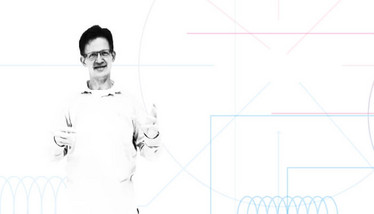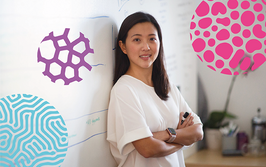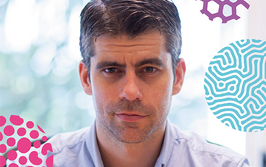The Coming of Age of Peter Schoenmakers
Peter Schoenmakers will be know to many readers as a visionary scientist, generous collaborator, entertaining lecturer and enthusiatic dancer. He recently received the prestigous Dal Nogare Award at Pittcon and will mark his 65th birthday at HPLC 2019 in Milan. To celebrate, we asked some of his colleagues, mentors and students to share their memories of Peter over the years.

Peter obtained his PhD in 1981 under the supervision of Leo de Galan in Delft, The Netherlands and Barry Karger in Boston, Massachusetts, USA, focusing on the modelling of gradient reversed-phase liquid chromatography (RPLC). Wolfgang Lindner from the University of Vienna remembers these early days well: “I’ve known Peter for more than 40 years, since I was a postdoc at Barry Karger’s lab in Boston and Peter was there as guest student during his PhD. This stay at Barry’s lab had a influenced his whole life, as he met his wife Dana there!”
Afterwards, Peter started working for Philips Research in Eindhoven, the Netherlands. Here, Peter continued to work on developing models for liquid chromatography (LC), but also entered the field of supercritical fluid chromatography (SFC). Hans-Gerd Janssen says, “At Philips Research in Eindhoven, Peter ran two large research projects. One developing an expert system for optimization in LC and the other exploring SFC. I worked as a young PhD student in Karel Cramers’ group on capillary SFC at Eindhoven University, just 5 km down the road. We decided to join forces and I spend half my time working with Peter at Philips. This really shaped my career – I sometimes wonder where I would have been without his guidance during those years.”
Dr. Mary Ellen McNally, now a Technical Fellow at FMC in Newark, Delaware, but then at DuPont, also remembers Peter’s revolutionary approach to SFC. “In the early days of SFC (1986 through 1995), there was a battle between the capillary and packed column experts on which was the best technique to move forward. The debate raged among academics and instrument company experts but industrial chemists, like Peter and me, just wanted to use the technique to solve problems.”
Peter would later move to Shell in Amsterdam before spending a few years in Houston, Texas. Together with Jan Blomberg and Jan Beens, Peter Schoenmakers contributed significantly to the development of comprehensive two-dimensional gas chromatography (GC×GC). The subsequent success of the technique in the field of petrochemical analysis was largely the result of their pioneering work.
Indeed, Peter has left his mark across many areas of chromatography, something which Sjoerd van der Wal, emeritus professor at Van 't Hoff Institute for Molecular Sciences, underlines: “The common thread throughout his research is the study and description of different forms of chromatography with easy-to-understand models that do not frighten users with their complexity. From modelling gradient RPLC during his PhD, to investigating the application of SFC in industry, and developing GC×GC, Peter has contributed on multiple fronts.”
The research component of his career was always a priority for Peter and in the late 1990s he took a post at the University of Amsterdam alongside to his job at Shell. Describing this experience, he says “I always assumed 50/50 meant evenly dividing the working week across two jobs but, in reality, it meant 50 hours in one place and 50 hours in the other.”
In 2002, he became full-time professor of polymer analysis and analytical chemistry at the University of Amsterdam, succeeding world-renowned chromatographer Hans Poppe. Here, Peter immediately boosted the impact of polymer HPLC, expanding the scope beyond size-exclusion chromatography towards other separation modes and multidimensional separations. Ron Peters, Principal Scientist at DSM Coating Resins in Waalwijk (The Netherlands) and part-time professor at the University of Amsterdam, says “Peter has made tremendous, ground-laying contributions to the characterization of polymers by his work on the application of multidimensional separations to complex polymeric systems.”
Ever since, his research focus has been on comprehensive two-dimensional (liquid) chromatography and applications of analytical chemistry in forensic science. Peter has published more than 300 papers and several book chapters, and his book, “Optimization of chromatographic selectivity – a guide to method development,” is still fundamental reading.
Peter is the chairman of the Separation and Characterization of Macromolecules (SCM) symposium series, a role which he embraces, says Harald Pasch, a professor at the University of Stellenbosch, South Africa: “My group always appreciates attending the SCM meetings and presenting our research – particularly the graduate students in the group who come to learn about the latest developments and speak to the most prominent scientists in the field. Along with the scientific program, the students thoroughly enjoy the conference party and I must give credit to Peter as being one of the most dedicated dancers at this event!”
Peter is also a member of the Permanent Scientific Committee of the HPLC series of conferences and editor for the Journal of Chromatography A and takes an active role in both. “I've worked with him on HPLC Conference series and the Journal of Chromatography A. In both settings, he naturally took a leading role through his common sense, thoughtfulness, and positive approach,” says Robert “Bob” Kennedy, a professor at the University of Michigan.
Xiaoli Wang, R&D Section Manager at Agilent Technologies, draws attention to the many awards Peter has received, which demonstrate the huge impact he has had: “Peter’s scientific accomplishments in the area of separation science are evident from the long list of honors on his CV. Some of the most prestigious awards include the Silver Jubilee medal from the Chromatographic Society in 1989, the EAS award for excellence in separation science in 2010, and the Csaba Horvath Memorial Award in 2015.” Other recent international awards include the CASSS Award (2015), the John H. Knox Medal of the RSC (Belgium, 2014) and the Martin medal of the Chromatographic Society (2011).
In 2016, Peter successfully applied for a European ERC Advanced grant for the project STAMP (Separation Technology for a Million Peaks) in which he and his team are developing three-dimensional microfluidic systems using 3D-printing technology, retention modelling, computational fluid dynamics, monolithic stationary phases and advanced imaging techniques.
Peter is a keen supporter of public–private partnerships, and was instrumental in founding COAST, an organization bringing together analytical chemists in industry and academia.
Despite his scientific accomplishments, Peter always makes time for young scientists, whose successes he sees as his true legacy. Within COAST, Peter instituted educational programs to allow talented students at all levels to receive additional training from analytical experts in industry and academia.
Asking current and former PhD students for their stories about Peter generated many tales of his support and encouragement – and his directness. “He will tell you immediately when you have made, or are about to make, a mistake,” agree Dorina Adamopoulou, Noor Abdulhussain and Pascal Breuer, PhD students within the large STAMP project. “But this constructive criticism is immediately followed by a positive note with suggestions and ideas for improvement.”
A young PhD student can learn a lot from Peter, as the authors know from experience. When Bob Pirok was nervously rehearsing his first conference lecture for HPLC2015 late at night in his hotel room, he received a text message from Peter ordering him to “Get down to the ‘beer tent’ now!”. The next morning, encumbered by a horrible hangover, Bob looked accusingly at Peter, who retorted cheerfully “Hey, at least you are no longer nervous!”. To Bob’s surprise, it worked.
Although we cannot recommend that other young scientists take this particular recommendation, Peter is certainly well qualified to advise on giving a memorable conference presentation. “Peter is a great speaker. I always enjoy his talks because I know that I will learn something, hear a visionary idea, and get a good laugh! His lectures provide vision and clarity for the field, and his excellent sense of humor permeates his talks,” says Bob Kennedy.
Ton Brooijmans, molecular characterization expert at DSM Coating Resins, Waalwijk (The Netherlands) agrees: “Peter is a dedicated participant in national and international meetings where he has always presented amazing analytical topics in a very amusing way. The combination Peter utilizes in his lecture: hardcore science, humor, inspiration and publicly giving credit to those who earned it, garnered my immediate respect and admiration.”
Amongst his collaborators, Peter is also known for his spontaneous creativity, which can transform everyday meetings into stimulating brainstorm sessions. Ira Lurie, Research Professor of Forensic Sciences at George Washington University, says “Peter and I were sitting in my office when I pointed out the need for some semi-quantitative means of describing the value of 2D-LC for improving the specificity of retention time measurements. Within 15 minutes, Peter derived an equation on my whiteboard to estimate the decrease in uncertainty of retention time measurements when employing multidimensional LC.”
Xiaoli Wang had a similar experience during his time as PhD student in Peter Carr’s group. “When Peter visited us in Minnesota, he told us about his work on isocratic Poppe plot, which was invented by another world-renowned Dutch chromatographer – Hans Poppe. That discussion immediately led us to an idea for a collaboration to extend the concept of Poppe plot from isocratic to gradient elution. We spent hours on making a Poppe plot. He was so meticulous about the graphical details. I was amazed by that!”
Peter’s ability to bring people together is a gift, says Sjoerd van der Wal: “With his kind personality, spontaneity, (sometimes bold) humor and tremendous effort, Peter collaborates with a large, international network.”
During the Dal Nogare Award session at Pittcon 2019 Peter laid out his vision of the future in chromatographic separations, and the pivotal role for multidimensional chromatography. He believes three-dimensional chromatography will one day be commonplace; however, he noted that complex method development already renders 2D-LC chromatography too costly for routine implementation in the industrial analytical lab and made a plea for better computer-aided method optimization tools to make 2D-LC more accessible.
Bob Pirok was delighted to contribute to the session by presentating an algorithm developed during his PhD, commenting: “It’s amazing to think that this work goes back to a paper Peter published in 1978, during his PhD, and algorithms he developed on a calculator. Even then, Peter realized the need for modelling retention in order to facilitate rapid and effective implementation of the complex chromatographic systems we need tomorrow. Looking at the conference program of HPLC2019 in Milan, we can see that this topic is now more relevant than ever.”
Van ’t Hoff Institute for Molecular Sciences, Analytical Chemistry Group, University of Amsterdam, the Netherlands.

















